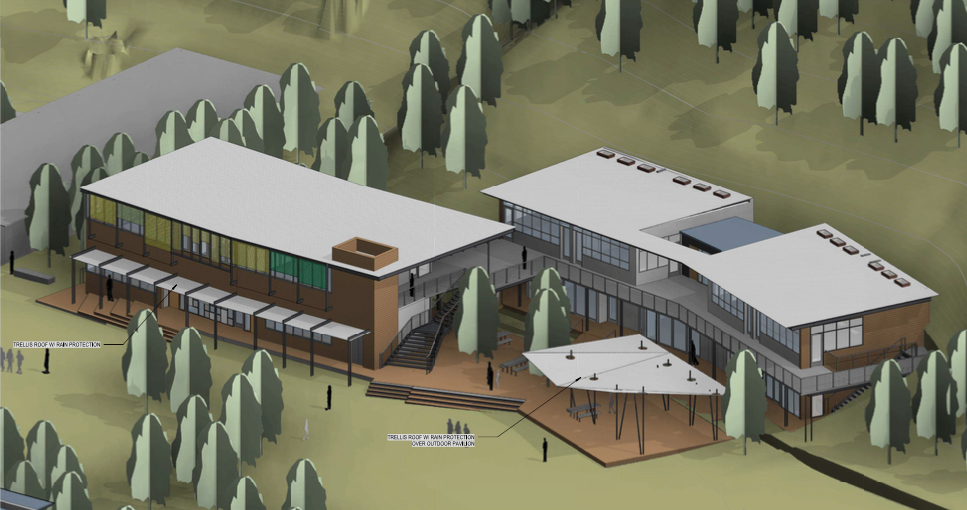The Marin Country Day School (MCDS) is planning to renovate their Upper Campus and restore the nearby local creek by the fall of 2018.
This project will replace the old science building with a new two-story structure that will bring the additional classrooms needed to maintain a class size of 14 and create a more cohesive feel to the campus, according to Ellen McGlynn, the Director of Development and Alumni Relations at MCDS.
“We have guiding principles for anything we do to one of our campuses, and it’s to build flexible spaces that will support a more collaborative, interdisciplinary curriculum,” McGlynn said. “Our guiding principle is maintaining character and quality of our existing campuses.”
In addition, a new performing arts center will be built and other small renovations will take place, including makeovers of bathrooms, offices and the outer field.
According to Scott Hardister, the Assistant Head for Strategic Implementation, the school wants to obtain all the necessary permits to begin construction by the end of December. If approved, he hopes the project will take two summers and one academic school year. The school plans to begin the project at the end of this school year in June, with the school reopening by fall 2018.
Junior Nicky Forbes attended MCDS from kindergarten through eighth grade and liked that the school was open and involved the outdoors.
“It had a really good performing arts and music department and I think building that new building will help expand that and be beneficial,” Forbes said.
According to McGlynn, the total estimated cost of the new structures and restoration is $24 million. However, there is no plan to increase enrollment costs.
There will be a total addition of 11,334 square feet to the campus with a total of 8,349 square feet of previous facilities destroyed, according to the Notice of Intent provided by the Town of Corte Madera.
The new science building will include classrooms that will allow the school to maintain a small class size and a ‘makerspace,’ a place where kids can create and innovate, according to McGlynn. Any additional space most likely will be used for a class related to science.
“The science spaces are very limiting so we trying to make more spaces that are more flexible and dynamic for students and teachers,” Hardister said.
There are some older science buildings that haven’t been remodeled since the ’70s, and since science is an ever-evolving subject, they were overdue for a update, according to McGlynn.
“I feel like some of the equipment [was] getting old and the setup of the school was a little funky,” Forbes said.
The new buildings will provide both indoor and outdoor working space, and the classrooms will exhibit a more open feel with sliding doors.
“Students and teachers will be less siloed and I think there will be a lot more interaction between departments. That’s the direction we’ve been going in for all of our classrooms but the [new] classrooms will lend to that,” McGlynn said.
The K-8 school is nestled in the side of Ring Mountain, across from the Bay, and sits next to a creek, making it a prime location for students to learn about the environment.
The school has restored the half of the creek that is closer to the Bay and its goal is to restore the section towards Ring Mountain. The school also plans to fix the foundation of the field adjacent to the creek because rain causes the field to become soggy and muddy.
“I think it’s the school being [a] good steward of the land. We are very lucky to be on the location that the school sits,” McGlynn said. “It’s about teaching our students about their responsibility to improve and take care their space.”
Once the Creek is restored, MCDS wants to integrate it more into the science programs.
“The more we can bring the outside in [the school] is a main focus for us,” McGlynn said.
While construction takes place, the classes will be moved to portable classrooms that are still located on the school grounds.
According to McGlynn, the last time they had a big project, the architect and developing company they were working with on the project collaborated with the school to give the students a chance to see what was taking place.
“[The companies] allowed there to be educational opportunities for students and teachers to come out and learn about the building project and sustainable initiatives that we had involved in the making of the building,” McGlynn said.
According to Hardister, they are confident that the construction project won’t affect student learning.
On Nov. 10, 2016 there was a public hearing for comments in the Corte Madera Town Hall.








